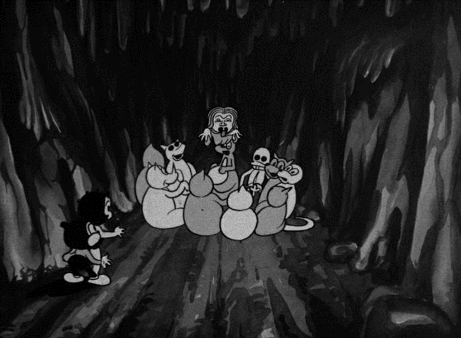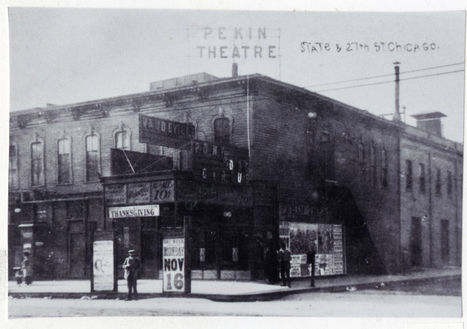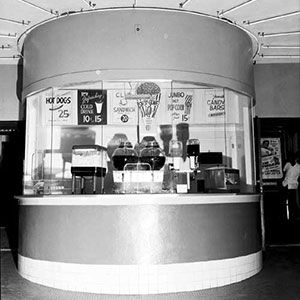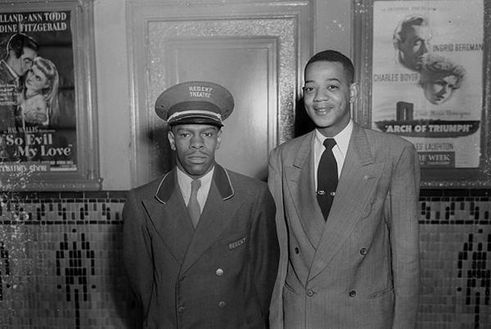
Going To The Show
Was a popular term to refer to the Moving Picture Show. Movies became immensely popular in the late 1920s with the advent of "talkies" or sound films. During the Great Depression it was a way for Americans to escape their troubles, it soon became our most popular form of entertainment.
Black and white Americans did not share the same movie going experience. Theaters were segregated and African Americans were not portrayed in a favorable light on the silver screen. This caused many African Americans to create their own movies screened in African American theaters. These were called Race Films and they gave rise to some of the most talented African American actors at the time. This gallery explores how movie theaters were back then.


Around the back and up the stairs
Metal Sign from The Grand Theater
July 1931
Unknown Artist

Sign of Segregation
Every aspect of life was segregated during Jim Crow. African Americans were made to sit in the balcony at shared movie theaters. The balcony seating area was known as the buzzard's roost because it was the least cared for.
Opening night at the Rex Theater, Hannibal, Missouri, April 4, 1912. Courtesy Q. David Bowers.
Source Signs of the Times

Photograph Pekin Theater
Source https://historictheatres.org/wp-content/uploads/2017/03/IL-Chicago-Pekin-BS-scrapbook-22-013.jpg
WHITE ONLY
BLACK ONLY
THEATERS
The Pekin Theater opened in Chicago in 1905. It was built by Iowa native Robert T. Motts, a professional gambler. The Pekin was the first African American theater in the city of Chicago.
The Lincoln Motion Picture Company was one of the first African American companies to create feature length race films.
This is the 1921 issuance of one hundred shares of the capital stock of the Lincoln Motion Picture Company.

Stock Certificate for the Lincoln Motion Picture company. Medium ink. Source, Collection of the Smithsonian National Museum of African American History and Culture.


Movie Ticket
A movie ticket from the African American Lincoln Theater in Charlotte, North Carolina only cost eleven cents. The theater opened in 1919. Adjusted for inflation, $0.11 in 1919 is equal to $1.74 today.
Theater ticket stub, 1919
Source College of Charlestonhttps://discovering.cofc.edu/items/show/21#&gid=1&pid=3
No more Midnight Rambles
Black theater goers could only watch movies at white theaters during matinee times or at midnight. These midnight shows were called midnight rambles.
Now that hey had their own theaters they didn't have to sit in the buzzard roost or watch midnight rambles.
They could sit anywhere and watch movies that starred an all black cast.

Lincoln Theater Movie theater entrance. Chicago, Illinois
Source The Library of Congress
C
o
n
c
e
s
s
i
O
n
s
Now a staple of movie culture, concession stands weren't always a thing. Candy counters became popular during the Great Depression as a way to bring movie goers back to the struggling theater. In the late thirties new candies and snacks such as Juicy Fruits and Milk Duds were beginning to become available and the candy counter became a familiar feature at the local theater.

1950 Candy Counter from the Lincoln Theater in Charleston, South Carolina. Source Charleston Library

Ashby Theater Projector 1932
The Ashby theater in Atlanta was built in 1934. African Americans were able to enjoy a feature, a newsreel and a cartoon for a dime at their local theater. Black theaters often played news reels of the progress Black soldiers were making abroad during World War II..
Cartoon Saturdays




Before television, Cartoons were shown at the movie theaters. Cartoons were created to be shown as shorts before the main feature of a film, the same way Pixar does today. On Saturdays, movie theaters would often advertise special cartoon matinees. Imagine 21 cartoons for 20 cents!
Jazz legends like Duke Ellington, Louis Armstrong, and Cab Calloway all lent their voices to popular animated shorts. The 1932 cartoon Minnie the Moocher is eight minutes long and features Cab Calloway and his Cotton Club Orchestra.

Cab Calloway
Photo by Frank Driggs - Image courtesy gettyimages.com














